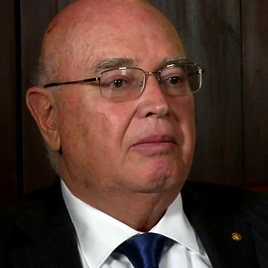Gábor A. Somorjai facts for kids
Quick facts for kids
Gábor A. Somorjai
|
|
|---|---|

Somorjai, c. 2001
|
|
| Born | May 4, 1935 Budapest, Hungary
|
| Died | July 7, 2025 (aged 90) |
| Nationality | American |
| Alma mater | Budapest University of Technology and Economics |
|
Notable work
|
University of California, Berkeley |
| Awards | Wolf Prize in Chemistry (1998) National Medal of Science (2001) Irving Langmuir Award (2007) William H. Nichols Medal (2015) Enrico Fermi Award (2023) |
Gabor A. Somorjai (May 4, 1935 – July 7, 2025) was a brilliant Hungarian-born American professor of chemistry. He taught at the University of California, Berkeley. He was a top expert in a field called surface chemistry and catalysis. This means he studied how the very outer layers of materials behave and how they help chemical reactions happen. His work, especially on how metal surfaces affect gas reactions, was very important. For his amazing contributions, Somorjai received many prestigious awards. These included the Wolf Prize in Chemistry in 1998 and the National Medal of Science in 2002. He also received the Priestley Medal in 2008 and the Enrico Fermi Award in 2023. Somorjai passed away on July 7, 2025, at the age of 90.
Contents
Gabor A. Somorjai: A Pioneer in Chemistry
Early Life and a Brave Journey
Gabor A. Somorjai was born in Budapest, Hungary, in 1935. During a very difficult time in history, his family faced great danger. Luckily, a brave person named Raoul Wallenberg helped his mother, him, and his sister get special papers. These papers kept them safe. His father also survived, though many other family members did not.
In 1956, Gabor was studying chemical engineering at the Budapest University of Technology and Economics. He took part in the 1956 Hungarian Revolution. After the Soviet invasion, he left Hungary and moved to the United States. Like many other Hungarian immigrants, Somorjai continued his studies at Berkeley. He earned his doctorate degree in 1960. He then worked at IBM's Thomas J. Watson Research Center for a few years. In 1964, he returned to Berkeley as a professor.
Unlocking the Secrets of Surfaces
In the 1950s and 1960s, new tools like low-energy electron diffraction changed how scientists studied surfaces. Early studies focused on materials like silicon, which are important for electronics. But Somorjai was interested in surfaces like platinum. Platinum is known for its special chemical properties.
How Surfaces Help Reactions
Somorjai made a big discovery. He found that tiny imperfections or "defects" on surfaces are where catalytic reactions happen. Catalysts are substances that speed up chemical reactions without being used up themselves. When these defects break, new connections form between atoms. This can turn simple chemicals into complex ones. For example, his work showed how a substance called naphtha could be changed into gasoline. These findings helped us understand many things better. This includes how things stick together (adhesion), how slippery surfaces are (lubrication), and how things rub against each other (friction). His research also had a big impact on nanotechnology. Nanotechnology is about working with materials at a super tiny scale.
Seeing the Invisible World
In the 1990s, Somorjai teamed up with physicist Yuen-Ron Shen. They developed a new method called Sum Frequency Generation Spectroscopy. This technique allowed them to study surface reactions without needing a special vacuum chamber. He also explored surface reactions at the atomic and molecular level. He used tools like the atomic force microscope and scanning tunnelling microscope. These amazing microscopes can also be used without a vacuum.
Ice Skating Science
Somorjai's deep knowledge of surfaces was even used for the 2002 Winter Olympics. He advised them on how to make ice-skating surfaces as fast as possible. His research showed something surprising about ice. He found that skaters actually glide on a top layer of rapidly vibrating molecules. Before this, many thought skaters glided on a thin layer of liquid water. His work changed how we understand the slipperiness of ice.
Throughout his career, Somorjai published over a thousand scientific papers. He also wrote three important textbooks on surface chemistry. He became one of the most frequently cited scientists in his field.
Major Awards and Honors
Gabor Somorjai received many important honors for his work. He was chosen to be a member of the United States National Academy of Sciences in 1979. He also joined the American Academy of Arts and Sciences in 1983. In 1998, he won the Wolf Prize in Chemistry. He shared this award with Professor Gerhard Ertl. The National Medal of Science was awarded to him in 2002. This is one of the highest honors a scientist can receive in the United States.
The American Chemical Society also gave him several awards. These included the Peter Debye Award and the Adamson Award. In 2008, he received the Priestley Medal. This is the highest award given by the American Chemical Society. It recognized his "extraordinarily creative and original contributions to surface science and catalysis." In 2023, he was awarded the Enrico Fermi Award. This is another very prestigious science and technology award from the U.S. government.
A Lasting Legacy in Science
Gabor A. Somorjai's impact on science continues even after his passing. An important award, the Gabor A. Somorjai Award for Creative Research in Catalysis, is given every year. It recognizes outstanding research in the field of catalysis. This award is supported by a fund created by Gabor and Judith K. Somorjai.
Also, the Gabor A. and Judith K. Somorjai Visiting Miller Professorship Award was created in 2011. This award helps visiting scientists in chemical sciences. It allows them to spend time at the Miller Institute at the University of California Berkeley. These awards ensure that his name and his passion for science inspire future generations of chemists.
See also
- List of chemistry awards

